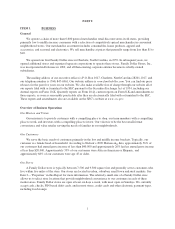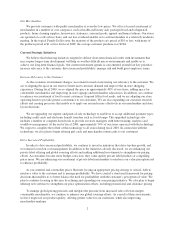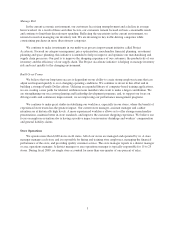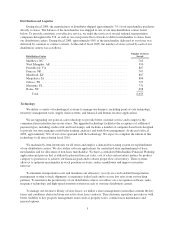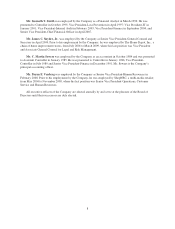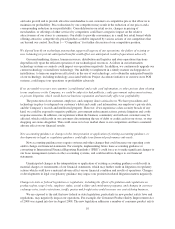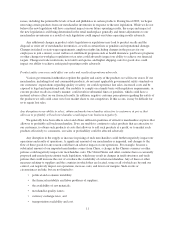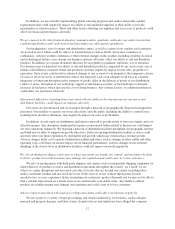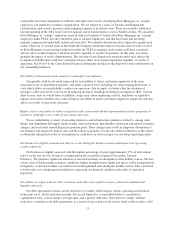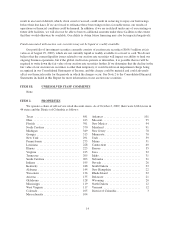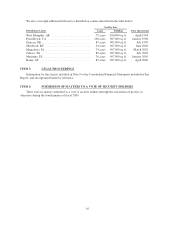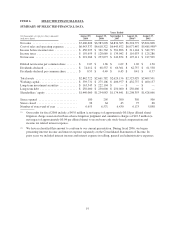Family Dollar 2009 Annual Report Download - page 19
Download and view the complete annual report
Please find page 19 of the 2009 Family Dollar annual report below. You can navigate through the pages in the report by either clicking on the pages listed below, or by using the keyword search tool below to find specific information within the annual report.issues, including the permissible levels of lead and phthalates in certain products. During fiscal 2009, we began
removing certain products from our merchandise inventories in response to the new legislation. While we do not
believe the new legislation will have a material impact on our future operating results, the scope and impact of
the new legislation is still being determined in the retail marketplace generally and future adjustments to our
merchandise inventories as a result of such legislation could impact our future operating results adversely.
Any additional changes in product safety legislation or regulations may lead to product recalls and the
disposal or write off of merchandise inventories, as well as certain fines or penalties and reputational damage.
Changes in federal or state wage requirements, employee rights (including changes in the process for our
employees to join a union), social welfare or entitlement programs such as health insurance, paid leave programs,
or other changes in workplace regulation or tax rates could adversely impact our ability to achieve our financial
targets. Changes in trade restrictions, new tariffs and quotas, and higher shipping costs for goods also could
impact our ability to achieve anticipated operating results adversely.
Product safety concerns could affect our sales and results of operations adversely.
Various governmental authorities regulate the quality and safety of the products we sell in our stores. If our
merchandise, including food and consumable products, do not meet applicable governmental safety standards or
our customers’ expectations regarding quality or safety, we could experience lost sales, increased costs and be
exposed to legal and reputational risk. Our inability to comply on a timely basis with regulatory requirements, or
execute product recalls in a timely manner, could result in substantial fines or penalties, which could have a
material adverse effect on our financial results. In addition, negative customer perceptions regarding the safety of
the products we sell could cause us to lose market share to our competitors. If this occurs, it may be difficult for
us to regain lost sales.
Any disruption in our ability to select, obtain and market merchandise attractive to customers at prices that
allow us to profitably sell such merchandise could impact our business negatively.
We generally have been able to select and obtain sufficient quantities of attractive merchandise at prices that
allow us to profitably sell such merchandise. If we are unable to continue to select products that are attractive to
our customers, to obtain such products at costs that allow us to sell such products at a profit, or to market such
products effectively to consumers, our sales or profitability could be affected adversely.
Any disruption in the supply or increase in pricing of such merchandise could further negatively impact our
operations and results of operations. A significant amount of our merchandise is imported, and changes to the
flow of these goods for any reason could have an adverse impact on our operations. For example, because a
substantial amount of our imported merchandise comes from China, a change in the Chinese currency or other
policies could negatively impact our merchandise costs. The United States and other countries have occasionally
proposed and enacted protectionist trade legislation, which may result in changes in tariff structures and trade
policies that could increase the cost of or reduce the availability of certain merchandise. Any of these or other
measures relating to suppliers and the countries in which they are located, some or all of which are beyond our
control, can negatively impact our operations, increase costs, and lower our margins. Such events or
circumstances include, but are not limited to:
• political and economic instability;
• the financial instability and labor problems of suppliers;
• the availability of raw materials;
• merchandise quality issues;
• currency exchange rates; and
• transportation availability and cost.
11


